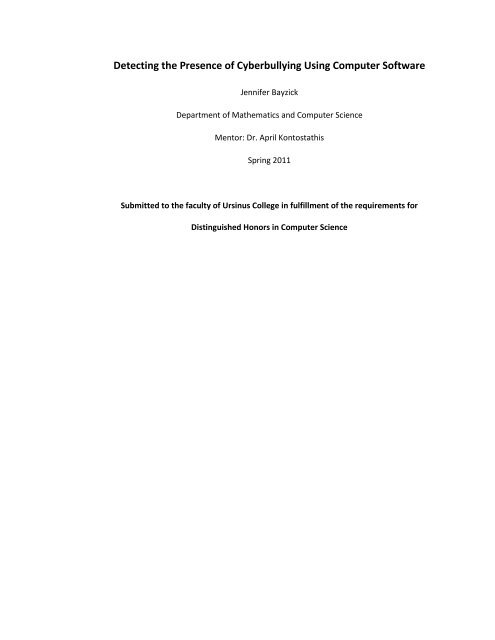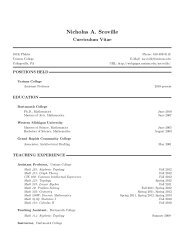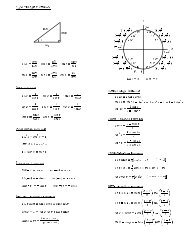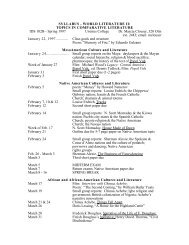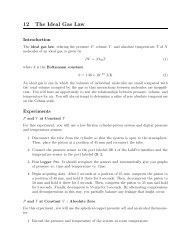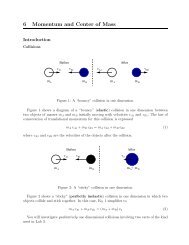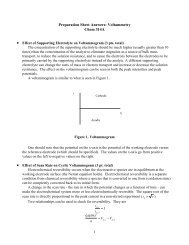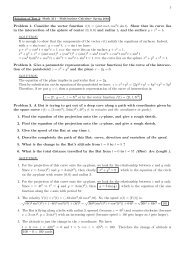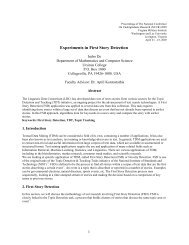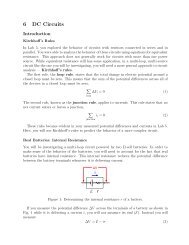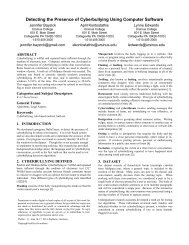Detecting the Presence of Cyberbullying Using Computer Software
Detecting the Presence of Cyberbullying Using Computer Software
Detecting the Presence of Cyberbullying Using Computer Software
- No tags were found...
You also want an ePaper? Increase the reach of your titles
YUMPU automatically turns print PDFs into web optimized ePapers that Google loves.
<strong>Detecting</strong> <strong>the</strong> <strong>Presence</strong> <strong>of</strong> <strong>Cyberbullying</strong> <strong>Using</strong> <strong>Computer</strong> S<strong>of</strong>twareJennifer BayzickDepartment <strong>of</strong> Ma<strong>the</strong>matics and <strong>Computer</strong> ScienceMentor: Dr. April KontostathisSpring 2011Submitted to <strong>the</strong> faculty <strong>of</strong> Ursinus College in fulfillment <strong>of</strong> <strong>the</strong> requirements forDistinguished Honors in <strong>Computer</strong> Science
Bayzick, <strong>Cyberbullying</strong> 2Distinguished Honors Signature PageJennifer Bayzick<strong>Detecting</strong> <strong>the</strong> <strong>Presence</strong> <strong>of</strong> <strong>Cyberbullying</strong> <strong>Using</strong> <strong>Computer</strong> S<strong>of</strong>twareAdvisor(s):____________________________________April KontostathisCommittee members:____________________________________April KontostathisOutside Evaluator:____________________________________Akshaye Dhawan____________________________________Lynne Edwards____________________________________John P. DoughertyApproved:____________________________________Roger Coleman
Bayzick, <strong>Cyberbullying</strong> 3Abstract<strong>Cyberbullying</strong> is willful and repeated harm inflicted through <strong>the</strong> medium <strong>of</strong>electronic text. The goal <strong>of</strong> this project is to design computer s<strong>of</strong>tware to detect <strong>the</strong>presence <strong>of</strong> cyberbullying in online chat conversations. Though <strong>the</strong>re are some commercialproducts that pr<strong>of</strong>ess to detect cyberbullying [6], none are research-based, and this projectprovides <strong>the</strong> foundations <strong>of</strong> research that could be used in home monitoring s<strong>of</strong>tware.What constitutes cyberbullying? What categorizes a chat post that containscyberbullying? What are <strong>the</strong> defining features <strong>of</strong> each category? The types <strong>of</strong> cyberbullyingdealt with in this project included <strong>the</strong> following: flooding, masquerade, flaming, trolling,harassment, cyberstalking, denigration, outing, and exclusion. Rules based on a dictionary<strong>of</strong> key words are used to classify a window <strong>of</strong> posts.Once <strong>the</strong> program implementing <strong>the</strong>se rules was built, its decisions had to be runagainst a truth set determined by human hand coders. We developed a truth set by givingeach window to three human coders. The final truth set was determined by a voting system,where, if at least two <strong>of</strong> <strong>the</strong> three coders labeled a window as containing cyberbullying, itwas labeled as cyberbullying in <strong>the</strong> truth set.The program was found to correctly identify windows containing cyberbullying85.30% <strong>of</strong> <strong>the</strong> time, and it identifies an innocent window correctly 51.91% <strong>of</strong> <strong>the</strong> time.Overall, it decides correctly 58.63% <strong>of</strong> <strong>the</strong> windows. This suggests that our coding rulesmust be refined to not falsely flag so much innocent conversation.
Bayzick, <strong>Cyberbullying</strong> 4Table <strong>of</strong> ContentsI. IntroductionII. <strong>Cyberbullying</strong> DefinedIII. Types <strong>of</strong> <strong>Cyberbullying</strong>IV. DatasetV. ChatCoder And Sexual PredationVI. BullyTracera. Swear wordsb. Insultsc. Second person pronounsd. Capital lettersVII. BullyTracer Design DetailsVIII. Evaluation and ResultsIX. Conclusion and Fur<strong>the</strong>r ResearchX. AcknowledgementsCitationsAppendix A – <strong>Cyberbullying</strong> CodebookAppendix B – CodeWord Dictionary
Bayzick, <strong>Cyberbullying</strong> 5I IntroductionWhatever happened to <strong>the</strong> standard, “Give me your lunch money, kid, or I’llpummel you?” Or for girls, how everyone in <strong>the</strong> seventh grade tolerated Sally at lunchtime,but as soon as she left <strong>the</strong> table, <strong>the</strong> topic <strong>of</strong> conversation moved to how her skirt did notmatch her blouse, how she should never do her hair like that again, and how she clearly hasno friends in <strong>the</strong> world. These are classic examples <strong>of</strong> traditional bullying, happening inperson between people who know each o<strong>the</strong>r. Though situations like <strong>the</strong>se still take placein almost every elementary and secondary school in <strong>the</strong> world, <strong>the</strong> availability <strong>of</strong> <strong>the</strong>Internet has allowed today’s youth to extend <strong>the</strong> harassment <strong>of</strong> peers to <strong>the</strong> virtual world aswell. <strong>Cyberbullying</strong> between classmates, as well as between Internet users who arestrangers <strong>of</strong>fline, is increasing at an alarming rate.In light <strong>of</strong> <strong>the</strong> increasing issue <strong>of</strong> cyberbullying today, we developed a program,BullyTracer, to detect <strong>the</strong> presence <strong>of</strong> cyberbullying in online conversation. It is a rule-basedsystem and was compared against human-coded truth sets. Our program was found tocorrectly identify 58.63% <strong>of</strong> <strong>the</strong> windows in <strong>the</strong> dataset. Though this is not accurateenough to implement in monitoring s<strong>of</strong>tware yet, this research provides backgroundknowledge about <strong>the</strong> components <strong>of</strong> cyberbullying conversation and <strong>of</strong>fers <strong>the</strong>ories onwhat would improve <strong>the</strong> accuracy <strong>of</strong> <strong>the</strong> program.
Bayzick, <strong>Cyberbullying</strong> 6II <strong>Cyberbullying</strong> DefinedPatchin and Hinduja define cyberbullying as “willful and repeated harm inflictedthrough <strong>the</strong> medium <strong>of</strong> electronic text [3].”For a conversation to be considered bullying, <strong>the</strong> intent <strong>of</strong> harm (physical, emotional,social, etc.) must be present. This includes:Threats <strong>of</strong> physical harm or violence, most <strong>of</strong>ten used by malesoo“I’m gonna beat <strong>the</strong> crap out <strong>of</strong> you after school tomorrow”“Ill kick ur face in punk”Any conversation meant to hurt <strong>the</strong> victim’s feelings. This is more commonlyemployed by girls, who focus on appearance and promiscuity; boys use insults too,although <strong>the</strong>y focus more on <strong>the</strong> victim’s masculinity, including sexuality, strength,and athleticism.oo“ur so fat and ugly no wonder you cant get a date”“ur such a fuckin homo go fuck ur bro<strong>the</strong>r”o “omg your so pretty can i be you....not.” 1Any comments meant to damage <strong>the</strong> reputation or social standing <strong>of</strong> <strong>the</strong> victim inan online or <strong>of</strong>fline community (a chat group, a sports team, a class in school, etc.)This includes comments not made to <strong>the</strong> victim directly, but to someone <strong>the</strong> victimlikes and respects, or comments put in public domain where <strong>the</strong> victim and o<strong>the</strong>rswill have accesso “Did she actually fuck him last night? Shes such a fucking slut, she’s up to 8in that frat”1 This example was taken from <strong>the</strong> personal page <strong>of</strong> user Alias1 on formspring.me.
Bayzick, <strong>Cyberbullying</strong> 7o“Dude totally fucked <strong>the</strong> gay guy last night, flaming homo”Willful harm excludes:Sarcasm between friends, in which one chat line taken out <strong>of</strong> context looksworse than it is. These examples are taken from chat conversations in which <strong>the</strong>users are known to be close friends.oo“yea yea whatever. Hobag”“I got your e-mail, slut, I can't believe someone so horrible could be sothoughtful”oPersonA: “i like my away message more than i like you”PersonA: “just thought i'd tell you”PersonB: “well I'm glad, so <strong>the</strong>n whenever I see you I make you miserable,which makes my day”PersonA: “ hahahah”PersonA: “you're such a whore”One or more comments meant to criticize or disagree with an opinion but notmeant to attack <strong>the</strong> individual. A comment like this can vary in degrees <strong>of</strong> “severity”or vulgarity, but much <strong>of</strong> this is dependent upon <strong>the</strong> reaction <strong>of</strong> <strong>the</strong> victim. This isdifficult to quantify because in many cases, it is not clear whe<strong>the</strong>r <strong>the</strong> bully meansto cause harm or if <strong>the</strong> victim is taking something too personally. For instance, aconversation like:PersonA: “I’m so psyched I got tickets to <strong>the</strong> Phillies game tomorrow! ”(a few lines later, after conversation from o<strong>the</strong>rs)PersonB: “The Phillies suck, I can’t believe anyone would want to see <strong>the</strong>m play! lol”
Bayzick, <strong>Cyberbullying</strong> 8Though this may seem insulting, this would not be considered cyberbullyingbecause it does not seem to directly and personally attack PersonA; it merelyexpresses a different opinion.What distinguishes a student who makes one nasty comment from a full-fledgedbully, ei<strong>the</strong>r in-person or online? A bully meaning to cause harm usually does not stop witha single malicious remark to <strong>the</strong> victim and may target more than one victim. If a bullysteals your lunch money once, it is likely that he will steal it again, and he may even move onto your nerdy friends. Similarly, a key element <strong>of</strong> cyberbullying is <strong>the</strong> fact that insultshappen repeatedly over time.By definition, cyberbullying must take place using an electronic medium. Patchinand Hinduja specify that <strong>the</strong> communication be through electronic text (as opposed totalking on <strong>the</strong> phone or sending pictures, videos, or o<strong>the</strong>r types <strong>of</strong> electronic media). Within<strong>the</strong> textual data, o<strong>the</strong>r mediums sometimes become relevant (pictures, video, etc.) and canbe used to determine context, but <strong>the</strong> vast majority <strong>of</strong> <strong>the</strong> data is in text format.One could also consider <strong>the</strong> definition <strong>of</strong> cyberbullying from <strong>the</strong> viewpoint <strong>of</strong> <strong>the</strong>victim, as opposed to <strong>the</strong> bully. Essentially, if one feels bullied, one is being bullied,regardless <strong>of</strong> <strong>the</strong> intentions <strong>of</strong> <strong>the</strong> bully. However, sentiment <strong>of</strong> intent is difficult todetermine online, so we focus on specific language and terminology.
Bayzick, <strong>Cyberbullying</strong> 9III Types <strong>of</strong> <strong>Cyberbullying</strong>The definitions above provide a <strong>the</strong>oretical description <strong>of</strong> cyberbullying. The goal <strong>of</strong>this project is to detect <strong>the</strong> presence <strong>of</strong> cyberbullying in chat transcripts, so more specificdescriptions are needed for <strong>the</strong> development <strong>of</strong> s<strong>of</strong>tware. Nine different methods <strong>of</strong>cyberbullying were found [1][2][4].i. FloodingFlooding consists <strong>of</strong> <strong>the</strong> bully repeatedly entering <strong>the</strong> same comment, nonsensecomments, or holding down <strong>the</strong> enter key for <strong>the</strong> purpose <strong>of</strong> not allowing <strong>the</strong>victim to contribute to <strong>the</strong> conversation. For example:Luke:Luke:Luke:Luke:Luke:Luke:Luke:Luke:Luke:Luke:Jack: Don'tLuke uses flooding against Jack and everyone else in <strong>the</strong> chat room as aform <strong>of</strong> intimidation. Jack’s response includes a protesting comment, “don't.”“Please don’t do that,” “stop,” “this really sucks,” etc. Then, <strong>the</strong> presence <strong>of</strong>multiple lines <strong>of</strong> blank or repeated comments by <strong>the</strong> bully, followed by aprotesting comment by ano<strong>the</strong>r user, <strong>the</strong> victim, would constitute flooding [2].ii. MasqueradeMasquerade involves <strong>the</strong> bully logging in to a website, chat room, or programusing ano<strong>the</strong>r user’s screenname. A masquerading bully can have a number <strong>of</strong>different motivations.
Bayzick, <strong>Cyberbullying</strong> 10• BullyA logs in under VictimA’s screenname to post inappropriate orembarrassing comments about VictimA and make it seem as though VictimAis talking about himself or herself.• BullyA logs in under VictimA’s screenname to harass VictimB and make itseem as though VictimA is <strong>the</strong> bully.• BullyA creates a new screenname for an imaginary UserC, <strong>the</strong>n harassesVictimA so that VictimA does not know who <strong>the</strong> comments are coming from.This technique is inherently difficult to detect, because online, if you sign intoa forum or chat room with a person’s screenname, you essentially are thatperson. There would have to be a conversation separate from <strong>the</strong> bullyingmedium (<strong>the</strong> particular chat room or website) between <strong>the</strong> victim and an outsideobserver in which <strong>the</strong> victim states that someone else had logged in under <strong>the</strong>irname and posted <strong>the</strong> comments.In <strong>the</strong> case where <strong>the</strong> bully creates a new user account to bully from, it iseven more difficult to detect masquerade. Having to enter minimal informationto create an account and allowing users’ information to be private makes it easyto create an anonymous account so <strong>the</strong> victim cannot tell from whom <strong>the</strong>harassment is coming. An alternative for <strong>the</strong> bully would be to lie about keyinformation so <strong>the</strong> bully’s actual information is not revealed. Some websites(such as formspring.me) even allow <strong>the</strong> posting <strong>of</strong> comments entirelyanonymously, making it very easy to harass someone.When looking to detect masquerade, <strong>the</strong>re is a bright side. Although <strong>the</strong>bully is harassing <strong>the</strong> victim from ano<strong>the</strong>r screenname, <strong>the</strong> bully uses <strong>the</strong> sametypes <strong>of</strong> methods and language any o<strong>the</strong>r bully would use. Then, to detect
Bayzick, <strong>Cyberbullying</strong> 11masquerade, <strong>the</strong> first step is to find bullying language in <strong>the</strong> way one woulddetect any o<strong>the</strong>r type <strong>of</strong> bullying. Once it is determined that cyberbullying hasoccurred, it can be categorized as masquerade in two ways. If it is found that <strong>the</strong>bully logged in under a stolen screenname, <strong>the</strong>n clearly masquerade hasoccurred. The o<strong>the</strong>r option would be to examine chat lines posted by <strong>the</strong> stolenscreenname after <strong>the</strong> bullying lines to see if <strong>the</strong>re is some sort <strong>of</strong> confrontationor accusation <strong>of</strong> stolen identity from <strong>the</strong> stolen screenname. The latter is notfoolpro<strong>of</strong>, but can provide evidence for <strong>the</strong> possible presence <strong>of</strong> masquerade [4].iii. Flaming (bashing)Flaming, or bashing, involves two or more users attacking each o<strong>the</strong>r on apersonal level. In this form <strong>of</strong> cyberbullying, <strong>the</strong>re is no clear bully and victim,and <strong>the</strong>re is little to no power differential between <strong>the</strong> participants. Theconversation consists <strong>of</strong> a heated, short lived argument, and <strong>the</strong>re is bullyinglanguage in all <strong>of</strong> <strong>the</strong> users’ posts [4]. For example,PersonA: “I like hats!”PersonB: “PersonA, this is <strong>the</strong> dumbest blog post on earth. You’re <strong>the</strong> dumbestperson on earth. You have no friends. Quit <strong>the</strong> Internet.”PersonA: “Really, well maybe I would, but that would leave only your blog forpeople to read, and since you have no friends to read it, <strong>the</strong> Internet wouldcollapse. Fuck your mo<strong>the</strong>r.”PersonB: “chinga tu madre, coño!” [Translation: “Fuck your mo<strong>the</strong>r, mo<strong>the</strong>rfucker!”]iv. Trolling (baiting)Trolling, also known as baiting, involves intentionally posting comments thatdisagree with o<strong>the</strong>r posts in <strong>the</strong> thread for <strong>the</strong> purpose <strong>of</strong> provoking a fight, evenif <strong>the</strong> comments don't necessarily reflect <strong>the</strong> poster’s actual opinion. The posterintends to arouse emotions and incite an argument, although <strong>the</strong> comments
Bayzick, <strong>Cyberbullying</strong> 12<strong>the</strong>mselves are not necessarily personal, vulgar, or emotional. For instance, ateenager finds a Jewish message board and posts, "The Holocaust neverhappened," or joins a pro-life thread and says, “well clearly abortion is okbecause <strong>the</strong> human life doesn’t begin until a baby is born, it’s just a bunch <strong>of</strong> cells[1].”v. HarassmentHarassment is <strong>the</strong> type <strong>of</strong> conversation that comes to mind when <strong>the</strong> term“cyberbullying” is mentioned, and it most closely mirrors traditional bullying with<strong>the</strong> stereotypical bully-victim relationship. With harassment, <strong>the</strong> bully and victimroles are clear, and <strong>the</strong>re is a definite power differential (physical, social, etc.)between <strong>the</strong> two participants. This type <strong>of</strong> cyberbullying involves repeatedlysending <strong>of</strong>fensive messages to <strong>the</strong> victim over an extended period <strong>of</strong> time. Aharassment conversation is generally not much <strong>of</strong> an argument because <strong>the</strong>victim plays a fairly passive role; sometimes <strong>the</strong> victim may send vulgar or<strong>of</strong>fensive messages back to <strong>the</strong> bully, but this is for <strong>the</strong> purpose <strong>of</strong> stopping <strong>the</strong>harassment, and <strong>the</strong> victim rarely, if ever, initiates conversation [4].vi. Cyberstalking and cyberthreatsCyberstalking and cyberthreats involve sending messages that include threats <strong>of</strong>harm, are intimidating or very <strong>of</strong>fensive, or involve extortion. Threats <strong>of</strong> harm,murder, or suicide, as well as “distressing material,” which may indicate that <strong>the</strong>person is upset and considering hurting <strong>the</strong>mselves or someone else, all fallunder cyberstalking. The line where harassment becomes cyberstalking isblurred, but one indicator might be when <strong>the</strong> victim begins to fear for his or hersafety or well-being, <strong>the</strong>n <strong>the</strong> act should be considered cyberstalking [4].
Bayzick, <strong>Cyberbullying</strong> 13vii. Denigration (putdowns)Denigration involves “dissing” or gossiping about someone online. Writing vulgar,mean, or untrue rumors about someone to ano<strong>the</strong>r user or posting <strong>the</strong>m to apublic community or chat room or website falls under denigration. The purposeis to harm <strong>the</strong> victim in <strong>the</strong> eyes <strong>of</strong> o<strong>the</strong>rs; not only does <strong>the</strong> victim hear <strong>the</strong>insults, but so does <strong>the</strong> rest <strong>of</strong> <strong>the</strong> community. There are entire websites thatare devoted to denigration, particularly in <strong>the</strong> college setting, such asjuicycampus.com (shut down as <strong>of</strong> February 5, 2009) and collegeacb.com (stillactive). These sites are set up so users can post conversation topics in newthreads and o<strong>the</strong>r users can comment, all anonymously, and <strong>the</strong>y have becomeexcellent sources <strong>of</strong> examples for this project, though <strong>the</strong>y have not yet beenused as primary data [4].viii. OutingOuting is similar to denigration, but requires <strong>the</strong> bully and <strong>the</strong> victim to have aclose personal relationship, ei<strong>the</strong>r online or in-person. It involves posting private,personal or embarrassing information in a public chat room or forum. Thisinformation can include stories heard from <strong>the</strong> victim, or personal informationsuch as passwords, phone numbers, or addresses. Emotionally, this is usuallymore harmful to <strong>the</strong> victim because <strong>the</strong> victim confided information to <strong>the</strong> bullyand <strong>the</strong> bully betrayed that trust. That <strong>the</strong> personal relationship between <strong>the</strong>bully and victim gives credibility to <strong>the</strong> information <strong>the</strong> bully disseminates.Sometimes trickery can be involved; <strong>the</strong> bully pretends <strong>the</strong>y are alone whenhaving a “private” online conversation, when o<strong>the</strong>rs are reading <strong>the</strong> conversationas well, or saying <strong>the</strong> conversation is in confidence, <strong>the</strong>n forwarding or posting all
Bayzick, <strong>Cyberbullying</strong> 14or parts <strong>of</strong> <strong>the</strong> conversation. In terms <strong>of</strong> <strong>the</strong> language used, outing is generallysimilar to denigration, although usually less vulgar and volatile [4].ix. ExclusionIn <strong>the</strong> survey conducted by Patchin and Hinduja, exclusion, or ignoring <strong>the</strong> victimin a chat room or conversation, was <strong>the</strong> type <strong>of</strong> cyberbullying reported to havehappened most <strong>of</strong>ten among youth and teens [3]. However, detecting exclusionwithout contact from <strong>the</strong> victim outside <strong>the</strong> chat room is not straight forward. If<strong>the</strong> victim reacts in a way that indicates <strong>the</strong>y think <strong>the</strong>y are being ignored (i.e.“hey guys, are you listening???”), <strong>the</strong>n it can be concluded that exclusion hashappened. However, if <strong>the</strong> victim brings up a topic or asks a question, but <strong>the</strong>subject is never responded to or brought up again, this constitutes exclusion butmay not be as easily distinguished [4].
Bayzick, <strong>Cyberbullying</strong> 15IV DatasetOur dataset consists <strong>of</strong> chat transcripts crawled from MySpace.com. Theconversations are thread-style forums, where a general topic is included in <strong>the</strong> creation <strong>of</strong><strong>the</strong> thread. Many users can post in <strong>the</strong> thread, and conversation usually deviates from <strong>the</strong>starting topic. When working with <strong>the</strong>se conversations, we considered a post to be a singlebody <strong>of</strong> chat text posted by a user at one time. The body <strong>of</strong> text could contain multiplesentences or even multiple paragraphs and still be considered a single post. Because <strong>of</strong> <strong>the</strong>interactive nature <strong>of</strong> cyberbullying, <strong>the</strong> conversations were processed using a movingwindow <strong>of</strong> 10 posts to capture context.Undergraduate research assistants from <strong>the</strong> Media and Communications StudiesDepartment developed a truth set for testing our algorithms. These individuals were givendirections for coding found in <strong>the</strong> codebook in Appendix A along with <strong>the</strong> definitions foundin sections III and IV. They reviewed each window and indicated whe<strong>the</strong>r or notcyberbullying is present. Three assistants coded each transcript, and a voting method wasused, where a window was considered to contain cyberbullying in <strong>the</strong> truth set if at leasttwo humans flagged it as such. These labelers also identified <strong>the</strong> type <strong>of</strong> cyberbullying and<strong>the</strong> lines that are involved in <strong>the</strong> instance <strong>of</strong> cyberbullying, but this information is notcurrently being used. Interestingly, though <strong>the</strong> coders generally agreed on <strong>the</strong> presence orlack <strong>of</strong> cyberbullying in a window, <strong>the</strong>y varied widely in <strong>the</strong>ir classification <strong>of</strong> an instance <strong>of</strong>cyberbullying. This can suggest ei<strong>the</strong>r that our category definitions need clarification or that<strong>the</strong> language is inherently ambiguous. In later stages <strong>of</strong> <strong>the</strong> project, <strong>the</strong> algorithms will befine-tuned in order to detect <strong>the</strong> distinction between different categories. It should be
Bayzick, <strong>Cyberbullying</strong> 16noted that we created our own truth set because <strong>the</strong>re was no set <strong>of</strong> transcripts coded forcyberbullying previously in existence.
Bayzick, <strong>Cyberbullying</strong> 17V ChatCoderThe general approach we used for BullyTracer was based upon ano<strong>the</strong>r program,ChatCoder, which was build to classify predatory language from chat conversations intocategories [5]. ChatCoder labels chat lines (single posts) in an instant message conversationinto one <strong>of</strong> three classes: personal information (<strong>the</strong> predator asks questions or volunteersinformation), grooming (any inappropriate or sexual language), or approach (talking aboutmeeting <strong>the</strong> victim in person or talking on <strong>the</strong> phone).ChatCoder contains a dictionary <strong>of</strong> relevant words separated into subcategoriesbased on parts <strong>of</strong> speech and <strong>the</strong> three coding classes. For instance, “I” is a first personpronoun, “come” and “see” are approach verbs, and “you” is a second person pronoun.ChatCoder highlights and saves all instances <strong>of</strong> words in <strong>the</strong> dictionary found in <strong>the</strong> body <strong>of</strong>a line <strong>of</strong> chat. Each line “remembers” which subcategories it contains words from.Once all words in <strong>the</strong> dictionary are highlighted, ChatCoder examines each line <strong>of</strong> chatbased on <strong>the</strong> subcategories it contains, classifies it if appropriate, and highlights <strong>the</strong>username <strong>of</strong> <strong>the</strong> lines classified as containing predatory language. For instance, <strong>the</strong> line byuser goodboyb88 : “I will come see you over and over” was classified as containingapproach language because it contained a first person pronoun, a second person pronoun,and an approach verb. This is only one <strong>of</strong> twelve rules ChatCoder uses to classify posts.
Bayzick, <strong>Cyberbullying</strong> 18VI BullyTracerBullyTracer is a program meant to detect <strong>the</strong> presence <strong>of</strong> different types <strong>of</strong>cyberbullying in a chat room conversation. We describe its first version in this section. Dueto <strong>the</strong> conversational nature <strong>of</strong> cyberbullying, threads were split into moving windows <strong>of</strong> 10posts each. Labeling is done at <strong>the</strong> window level currently, and later stages <strong>of</strong> <strong>the</strong> projectwill distinguish between types <strong>of</strong> cyberbullying, and <strong>the</strong> lines involved in cyberbullying.BullyTracer analyzes all files in given directory using a rule-based algorithm. The programevaluates each window on a number <strong>of</strong> different levels.A. Post levelThe dictionary <strong>of</strong> code words used by BullyTracer appears in Appendix B. It includesterms in <strong>the</strong> categories: insult word(retarded, dumb), swear word (bitch, fucker),and second person pronouns (you, your). BullyTracer marks each post in a windowwith <strong>the</strong> category <strong>of</strong> any words found in <strong>the</strong> dictionary. These categories werechosen because <strong>the</strong>y seemed to have <strong>the</strong> highest correlation to <strong>the</strong> presence <strong>of</strong>cyberbullying in a chat post. Insults and swear words indicate hostility and meanspiritednessfrom <strong>the</strong> user who posted <strong>the</strong>m. Second person pronouns help todistinguish <strong>the</strong> object <strong>of</strong> <strong>the</strong> nasty words. For instance, <strong>the</strong> post “you are so dumbyou make me want to kill someone” should be distinguishable from <strong>the</strong> post “thattest was so dumb it was killing me.” Even though <strong>the</strong> two posts have many words incommon, <strong>the</strong> former should be coded as cyberbullying and <strong>the</strong> latter should not.As seen in section IV, some <strong>of</strong> <strong>the</strong> categories <strong>of</strong> cyberbullying include insultsdirected at a third party, such as, “she’s so fat.” However, <strong>the</strong> MySpace dataoverwhelmingly focuses on direct bully-to-victim cyberbullying. Any instances <strong>of</strong> an
Bayzick, <strong>Cyberbullying</strong> 19insult to a third party were directed at celebrities in pop culture, politics, or someo<strong>the</strong>r realm <strong>of</strong> public interest.Within <strong>the</strong> dictionary, some formatting issues needed to be addressed. Forinstance, spacing is particularly important. The word “ass” as a swear word isimportant to <strong>the</strong> dictionary, but it should not be considered a swear word whenused in <strong>the</strong> word “pass.” Therefore, <strong>the</strong> entry in <strong>the</strong> dictionary is “ ass ” and wordssuch as “asshole” and “dumbass” needed to be included separately. Similarly, inonline conversation, users frequently use Internet shorthand when typing. So in <strong>the</strong>line “u want 2 go 2 <strong>the</strong> mall?”, “U” is a second person pronoun. To cover <strong>the</strong>secases without identifying each instance <strong>of</strong> <strong>the</strong> letter u in <strong>the</strong> body <strong>of</strong> <strong>the</strong> post, <strong>the</strong>dictionary includes entries for “ u “ and “ ur ” (you’re).Additionally, some words fall into multiple categories. For instance, wordslike “bitch” and “asshole” are considered both insults and swear words, while “idiot”is considered an insult and “fuck” is only a swear word.Ano<strong>the</strong>r indication <strong>of</strong> hostile language is <strong>the</strong> use <strong>of</strong> many capital letters.General use <strong>of</strong> capitals at <strong>the</strong> beginnings <strong>of</strong> sentences or sparingly is normal, but if<strong>the</strong> percentage <strong>of</strong> capital letters to lowercase letters is greater than 50%, <strong>the</strong> post isconsidered to contain cyberbullying.Currently, a single post is considered to contain cyberbullying if it containsan insult word and a second person pronoun.B. User levelEach user is <strong>of</strong>ten associated with multiple posts in a particular window, andknowing which posts belong to which user can help BullyTracer gain informationabout a user’s conversational style and <strong>the</strong> context <strong>of</strong> <strong>the</strong> window’s conversation.
Bayzick, <strong>Cyberbullying</strong> 20For example, <strong>the</strong> severity <strong>of</strong> a swear words can be examined by looking at<strong>the</strong> number <strong>of</strong> swear words a particular user uses in general conversation. This willbe more helpful when enough data has been collected that a “user history” can bestored and <strong>the</strong> vulgarity <strong>of</strong> a user can be examined over time. Currently, <strong>the</strong>number <strong>of</strong> swear words a user types in a post divided by <strong>the</strong> number <strong>of</strong> swearwords in <strong>the</strong> entire window determines <strong>the</strong> vulgarity <strong>of</strong> a post. The connectionbetween <strong>the</strong> vulgarity <strong>of</strong> a post and <strong>the</strong> presence <strong>of</strong> cyberbullying has not yet beenestablished.A user is considered to be a cyberbully if one or more lines <strong>of</strong> chat posted by<strong>the</strong> user in a thread are considered cyberbullying.C. Window levelA window is labeled as containing cyberbullying if it contains any posts that arelabeled as containing cyberbullying. As described in section III, a single line <strong>of</strong> nastyconversation may not be considered cyberbullying. The window level wasconceptualized to be primarily concerned with distinguishing between types <strong>of</strong>cyberbullying. BullyTracer was designed to be expandable in later stages <strong>of</strong> <strong>the</strong>project.It should be noted, however, that while development has begun on animplementation <strong>of</strong> ChatCoder as a research-based Internet monitoring tool,BullyTracer is far more preliminary. This paper lays <strong>the</strong> groundwork for fur<strong>the</strong>rexamination <strong>of</strong> <strong>the</strong> linguistic components <strong>of</strong> a cyberbullying conversation, <strong>the</strong>distinction between various types <strong>of</strong> cyberbullying, and <strong>the</strong> algorithms used todetect <strong>the</strong> presence <strong>of</strong> cyberbullying language.
Bayzick, <strong>Cyberbullying</strong> 21VII BullyTracer Design DetailsThis section will examine <strong>the</strong> specific design details <strong>of</strong> BullyTracer. The program iswritten in <strong>the</strong> Java programming language. A class diagram is seen in Figure 1.BullyTracer Class DiagramThreadList <strong>of</strong> posts <strong>of</strong> achat log – windowList <strong>of</strong> usersPostUserTimestampBodyList <strong>of</strong> Subcategories<strong>Cyberbullying</strong> or InnocentFile DirectoryList <strong>of</strong> threads –windowsPerforms reliabilitycalculationsUserUsernameLocation information (providedby MySpace)Probable bully or victimUserwritesa postDictionaryhighlights words inbody <strong>of</strong> postDictionaryEntries withsubcategoriesFigure 1: a class diagram for BullyTracerWhen <strong>the</strong> program begins running, it loops through all <strong>the</strong> files in a pre-defineddirectory, and processes all files that are in XML format. It is assumed that each xml filecontains a single window because a companion program was built to split an entire threadinto windows <strong>of</strong> 10 lines. Within <strong>the</strong> program, a FileDirectory contains <strong>of</strong> all <strong>the</strong> windows in<strong>the</strong> given root directory, a thread is be used to describe <strong>the</strong> entire conversation in <strong>the</strong> filecontaining a single window, a user contains all information about a user that posts in a giventhread, and a post constitutes a single line <strong>of</strong> chat posted by a user. A post has anassociated post ID, user ID, body, and timestamp, as well as a number <strong>of</strong> different attributesbased on <strong>the</strong> content <strong>of</strong> <strong>the</strong> body. In <strong>the</strong> program, a user keeps track <strong>of</strong> its own user ID,
Bayzick, <strong>Cyberbullying</strong> 22username, location, which posts within <strong>the</strong> chat log have been posted by that user, as wellas a number <strong>of</strong> attributes based on <strong>the</strong> bodies <strong>of</strong> <strong>the</strong> posts by <strong>the</strong> user.
Bayzick, <strong>Cyberbullying</strong> 23VIII Evaluation and ResultsEvaluation <strong>of</strong> BullyTracer’s coding rules was done based on how closely <strong>the</strong>program’s decisions matched <strong>the</strong> human-defined truth set for each window. As shown inTable 1, <strong>the</strong> program counts <strong>the</strong> number <strong>of</strong> correctly identified windows that containcyberbullying and innocent conversation, as well as <strong>the</strong> number <strong>of</strong> windows that areinnocent but identified as containing cyberbullying (false positives) and <strong>the</strong> number <strong>of</strong>windows that contain cyberbullying but were incorrectly identified as innocent conversation(false negatives). The windows in packets 1 and 2 were examined closely to develop <strong>the</strong>rules in BullyTracer, but this does not seem to have a significant effect on <strong>the</strong> results forthose packets. Also included in <strong>the</strong> table is <strong>the</strong> percentage <strong>of</strong> windows in <strong>the</strong> packet thatcontain cyberbullying.Table 1: BullyTracer ResultsPacketNumberNumber<strong>of</strong>Windowsin PacketCorrectlyIdentifiedBullyingFalseNegativesCorrectlyIdentifiedInnocentFalsePositivesPercent <strong>of</strong>windowscontainingBullyingPercentCorrect1 131 19 3 91 18 16.793 83.9692 148 32 1 29 86 22.297 41.2163 226 77 8 55 86 37.610 58.4074 207 0 0 136 71 0.000 65.7005 196 10 1 130 55 5.612 71.4296 199 39 0 42 118 19.597 40.7047 212 57 2 81 72 27.830 65.0948 169 0 8 58 103 4.733 32.3209 210 31 14 105 60 21.428 64.76210 178 42 12 52 72 30.337 52.80911 186 47 12 76 51 31.720 66.129
Bayzick, <strong>Cyberbullying</strong> 24As seen in table 1, BullyTracer codes fairly consistently, even considering that some<strong>of</strong> <strong>the</strong> packets were used to create <strong>the</strong> coding rules and o<strong>the</strong>rs were not. Overall, <strong>the</strong>BullyTracer coding decisions match <strong>the</strong> human truth set 58.63% <strong>of</strong> <strong>the</strong> time. Percentages <strong>of</strong>correct coding vary by packet between 32.32% and 83.969%. We see that, <strong>of</strong> <strong>the</strong> 415windows that actually contain cyberbullying, BullyTracer labeled 354 <strong>of</strong> <strong>the</strong>m correctly,which is correct 85.30% <strong>of</strong> <strong>the</strong> time. The program rarely incorrectly identifies a window that<strong>the</strong> truth set labels as containing cyberbullying, which says that our coding rules seem tocapture <strong>the</strong> essence <strong>of</strong> cyberbullying conversation.The program is less able to identify innocent conversation, as <strong>the</strong>re is a largepercentage <strong>of</strong> false positives (innocent windows identified as containing cyberbullying) anda smaller number <strong>of</strong> false negatives (windows that contain cyberbullying but are labeled asinnocent). Of <strong>the</strong> 1647 innocent windows, BullyTracer codes 855 <strong>of</strong> <strong>the</strong>m correctly, which iscorrect 51.91% <strong>of</strong> <strong>the</strong> time. This suggests that our coding rules are too broad and need to berefined. One cause <strong>of</strong> this is <strong>the</strong> nature <strong>of</strong> our data. The project studies general onlineconversation, and this can include multiple user threads, chat rooms, or one-on-one instantmessage conversations. Our current test data comes exclusively from MySpace in threadstyleforums, where many users can post on a given topic. In contrast to instant messagestyle chats, where posts are usually extremely short, users in <strong>the</strong> MySpace threads <strong>of</strong>tenpost multiple sentences or multiple thoughts in a single post. This makes it difficult todistinguish between sentences or thoughts within a post, so sometimes associations aremade incorrectly. For example, a post that says, “Did you finish reading that book for classyet? Man it’s so freaking stupid!” would be flagged as containing cyberbullying because <strong>the</strong>second person pronoun “you” and insult word “stupid” are found in <strong>the</strong> same post.
Bayzick, <strong>Cyberbullying</strong> 25However, this is incorrectly flagged because “stupid” does not refer to “you.” Manyexamples like this have been found in our dataset.Ano<strong>the</strong>r issue is strangely worded insults or sentences that do not fit a particularpattern that can be coded for. Human language styles vary inherently between people, and<strong>the</strong> Internet setting fur<strong>the</strong>r loosens grammatical, spelling, and vocabulary standards. Forexample, consider this conversation between two users:Black Sheep SuzieQ: Quite an ironic quote coming from someone I ga<strong>the</strong>r supports<strong>the</strong> Bush agenda.Agent Working MySpace: You ga<strong>the</strong>red wrong. By <strong>the</strong> look <strong>of</strong> your blogs it seemsthis isn't <strong>the</strong> first time.This is considered to contain cyberbullying in our truth set because <strong>the</strong> second user isattempting to insult <strong>the</strong> first user, but <strong>the</strong> way <strong>the</strong> insult is set up does not lend itself tobeing classified. Research on <strong>the</strong> linguistic components <strong>of</strong> <strong>the</strong> conversation is necessary todetect this instance <strong>of</strong> cyberbullying.Sarcasm and good natured teasing are also troublesome. The exact same body <strong>of</strong> apost can be cyberbullying in one instance and a good natured ribbing in ano<strong>the</strong>r. Morefeatures pertaining to <strong>the</strong> contextual components <strong>of</strong> a good natured conversation needs tobe done in order to be able to identify a sarcastic post as innocent.
Bayzick, <strong>Cyberbullying</strong> 26IX Conclusion and Fur<strong>the</strong>r ResearchThis project defines nine types <strong>of</strong> cyberbullying and proposes methods to detect <strong>the</strong>presence <strong>of</strong> <strong>the</strong>se types in online chat conversations. It also describes <strong>the</strong> firstimplementation <strong>of</strong> algorithms to detect <strong>the</strong> presence <strong>of</strong> cyberbullying on a window level in<strong>the</strong> program called BullyTracer. Fur<strong>the</strong>r research includes refining <strong>the</strong>se methods andexpanding <strong>the</strong>m to distinguish between different types <strong>of</strong> cyberbullying. Throughout thisproject, <strong>the</strong> only data available for examination was a set <strong>of</strong> thread-style conversations fromwww.myspace.com.BullyTracer was found to correctly identify windows containing cyberbullying 85.30%<strong>of</strong> <strong>the</strong> time, and it identifies an innocent window correctly 51.91% <strong>of</strong> <strong>the</strong> time. Overall, itdecides correctly 58.63% <strong>of</strong> <strong>the</strong> windows. This suggests that our coding rules must berefined to not falsely flag so much innocent conversation.Future work on <strong>the</strong> project includes examining instances where BullyTracer codesincorrectly more closely, particularly <strong>the</strong> false positives, and refining BullyTracer’s rulesaccordingly. The importance <strong>of</strong> capital letters and swear words should also be examinedmore deeply. More ambitious goals include examining <strong>the</strong> role <strong>of</strong> context in distinguishingbetween types <strong>of</strong> cyberbullying and developing rules to classify windows into one <strong>of</strong> <strong>the</strong>nine cyber-bullying categories we define in this work.One <strong>of</strong> <strong>the</strong> most important contributions <strong>of</strong> this work was <strong>the</strong> creation <strong>of</strong> <strong>the</strong>MySpace cyberbullying truth set. There was previously no truth set in existence forcyberbullying, and so ours has been requested by a number <strong>of</strong> o<strong>the</strong>r research teams.
Bayzick, <strong>Cyberbullying</strong> 27X AcknowledgementsThe author would like to thank Dr. April Kontostathis and Dr. Lynne Edwards for all <strong>of</strong><strong>the</strong>ir help and support, as well as India McGhee, Bryan Stafford, Brett Thom, Rosie Kress, LizKilmer, Magdalena Parks, Brett Neslen, Sarah Anne Rosner, Katie Haldeman and <strong>the</strong> UrsinusCollege Summer Fellows program. This material is based upon work supported by <strong>the</strong>National Science Foundation under Grant No. 0916152. Any opinions, findings, andconclusions or recommendations expressed in this material are those <strong>of</strong> <strong>the</strong> author(s) anddo not necessarily reflect <strong>the</strong> views <strong>of</strong> <strong>the</strong> National Science Foundation.
Bayzick, <strong>Cyberbullying</strong> 28Citations[1] Glossary <strong>of</strong> cyberbullying terms. (2008, January). Retrieved fromhttp://www.adl.org/education/curriculum_connections/cyberbullying/glossary.pdf[2] Maher, D. (2008). <strong>Cyberbullying</strong>: an ethnographic case study <strong>of</strong> one australian upperprimary school class. Youth Studies Australia, 27(4), 50-57.[3] Patchin, J., & Hinduja, S. “Bullies move beyond <strong>the</strong> schoolyard; a preliminary look atcyberbullying.” Youth violence and juvenile justice. 4:2 (2006). 148-169.[4] Willard, Nancy E. <strong>Cyberbullying</strong> and Cyberthreats: Responding to <strong>the</strong> Challenge <strong>of</strong> OnlineSocial Aggression, Threats, and Distress. Champaign, IL: Research, 2007. Print.[5] I. McGhee, J. Bayzick, A. Kontostathis, L. Edwards, A. McBride and E. Jakubowski.Learning to Identify Internet Sexual Predation. In International Journal <strong>of</strong> ElectronicCommerce. To appear.[6] http://www.netnanny.com/
Bayzick, <strong>Cyberbullying</strong> 29Appendix A – <strong>Cyberbullying</strong> CodebookThis is <strong>the</strong> information our undergraduate assistants were given to learn to code chattranscripts for cyberbullying. They had <strong>the</strong> opportunity to ask questions at any time <strong>of</strong>myself or Pr<strong>of</strong>essors Kontostathis and Edwards for clarification. The reference to mySummer Fellows paper encompasses <strong>the</strong> information in sections III and IV <strong>of</strong> this paper.Directions for Hand Coders:Thank you so much for helping us out!!So <strong>the</strong> plan:My honors project is on <strong>the</strong> detection <strong>of</strong> cyberbullying in online chat conversations. My goalis to build a program – BullyTracer – that will detect <strong>the</strong> presence <strong>of</strong> cyberbullying based ona set <strong>of</strong> rules I need to develop. To decide what should and should not constitutecyberbullying (and <strong>the</strong>n train <strong>the</strong> computer to recognize it), I need “correct answers” – that’swhere you come in. I need o<strong>the</strong>rs’ opinions on what should and should not constitutecyberbullying to develop <strong>the</strong> program, and I also need truth sets to determine if <strong>the</strong>computer is doing what it should be.To begin, please read through my Summer Fellows paper – <strong>the</strong> file labeledBayzickBullyTracerSFFinal.docx. The whole thing will be good background information, but<strong>the</strong> only section that is necessary is section IV – Types <strong>of</strong> <strong>Cyberbullying</strong>. With research, Idiscovered and defined nine categories that cyberbullying conversation can fall into. Becomefamiliar with <strong>the</strong>se categories, but realize <strong>the</strong>re is also much ambiguity between <strong>the</strong>m, aswell as between cyberbullying and innocent conversations. The first few sections <strong>of</strong> my papergive background information on cyberbullying itself, and <strong>the</strong> last few sections describe myplan for my honors project. If you have any suggestions or comments for my research, pleaselet me know!So, as for <strong>the</strong> actual coding,1. Locate <strong>the</strong> Excel spreadsheet entitled Human Data Sheet 1.xlsx. Fill in your name at<strong>the</strong> top. Note: you should have a new copy <strong>of</strong> <strong>the</strong> data sheet to fill in for each newpacket <strong>of</strong> files you are working on (<strong>the</strong> packets will contain 100 – 200 files to beanalyzed). When you save your edited copy <strong>of</strong> <strong>the</strong> file, please label it as “HumanData Sheet [your last name] packet [packet number].xlsx”2. In each packet, <strong>the</strong>re are html files that contain windows <strong>of</strong> 10 chat lines that areexcerpts from longer chat conversations. All data was crawled (saved by anautomated computer program) from MySpace thread-style conversations, in which
Bayzick, <strong>Cyberbullying</strong> 30multiple users can chat about a specified topic, though conversations do not alwaysstay on that topic. Some windows include <strong>the</strong> entire thread, while o<strong>the</strong>rs are somesection <strong>of</strong> a much larger conversation. Locate <strong>the</strong>se files.3. For a particular file: Open <strong>the</strong> html file in your web browser or notepad/wordpadprogram. Read through <strong>the</strong> conversation excerpt. Enter <strong>the</strong> file name into <strong>the</strong>spreadsheet. If <strong>the</strong>re is language (a post or a group <strong>of</strong> posts) that you thinkconstitute cyberbullying, note that in <strong>the</strong> spreadsheet in <strong>the</strong> “Is <strong>Cyberbullying</strong>Present? (Y/N)” column, and <strong>the</strong> line numbers (all files should be labeled 1-10) thatare involved in <strong>the</strong> “Chat Lines Involved” column. Make a best guess at <strong>the</strong> categoryit falls into. It is more important to identify <strong>the</strong> presence <strong>of</strong> cyberbullying than toclassify it correctly. However, classification is helpful too. If you would like to makeany notes about <strong>the</strong> language used, <strong>the</strong> ambiguity <strong>of</strong> <strong>the</strong> category you chose, <strong>the</strong>style <strong>of</strong> a particular user, or anything else you think <strong>of</strong>, feel free to do that in <strong>the</strong>spreadsheet to <strong>the</strong> right <strong>of</strong> <strong>the</strong> designated columns. Any comments would be helpfulfor my analysis.4. Note: most conversations you will read will probably be considered innocent andmight be boring. I apologize. However, if <strong>the</strong>re are any innocent conversations thatlook like cyberbullying but you would not consider <strong>the</strong>m to be “bad” enough to beclassified, notes on those examples would be particularly helpful to determine where<strong>the</strong> line falls between cyberbullying and trash talking or innocent conversation. Also,<strong>the</strong>re do not have to be notes for each file (window), but if <strong>the</strong>re is somethinginteresting going on, please comment.5. Once you finish documenting a particular html file, congratulations!! Pick a new one,rinse, and repeat. When you have finished all files in a packet, make sure to saveyour human data sheet, and start a new packet <strong>of</strong> files! Remember, <strong>the</strong>re should bea separate data sheet for each packet (so your excel file doesn’t get too crazy long)Things I’m thinking about:1. The difference in language patterns in cyberbullying versus innocent conversationversus trash talking, and how to distinguish between <strong>the</strong>m in a systematic way.2. Users’ roles in <strong>the</strong> cyberbullying (bully/victim, multiple bullies harassing one or morevictims, multiple users attacking each o<strong>the</strong>r, but with no clear victim) and how thisplays a part in <strong>the</strong> classification <strong>of</strong> <strong>the</strong> window.3. Ways in which a computer could begin to classify conversations (think hard and fastrules, a computer doesn’t do ambiguity)4. Where can we go from here?
Bayzick, <strong>Cyberbullying</strong> 315. Lots <strong>of</strong> o<strong>the</strong>r random things that I’m blanking on right now – if you have anysuggestions, please let me know!!Thank you again for helping us all out!! You are a particular help to me and my honorsproject, so thank you! If you have any questions/comments/concerns/suggestions, feel freeto let me know at jebayzick@ursinus.edu.Thanks again!!~Jen BayzickSenior, ma<strong>the</strong>matics and computer science
Bayzick, <strong>Cyberbullying</strong> 32Appendix B – Codeword DictionaryThese are all <strong>the</strong> words that are flagged as contributing to cyberbullying conversation in achat post. Take note that some entries fall under multiple categories based on <strong>the</strong>irmeaning and vulgarity. Also, entries that include quotation marks (“ “) were not used in <strong>the</strong>dictionary; <strong>the</strong> quotation marks are <strong>the</strong>re to highlight special spacing issues before or after<strong>the</strong> word.Dictionary EntryCoding Categorybullshitswear“shit “swearfuckswearfuckerswearf*ckswearf**kswearf***swear“ ass “ sweardamnsweardumbuttsweardumbbuttsweardumbassswearjackassswearassholeswearbitchswearretardedinsultstupidinsultdumbinsultdipshitinsult“ tard” insultidiotinsultloserinsultwhoreinsult“ ho “ insult“ hoe “ insultdoucheinsult
Bayzick, <strong>Cyberbullying</strong> 33douchebaginsult“ cock “ insultslutinsultcuntinsultuglyinsultbitchinsultskankinsulthoebaginsultgayinsult“ fag ” insultfaggotinsult“ oaf” insultignorantinsultloserinsultpussyinsultpa<strong>the</strong>ticinsultshi<strong>the</strong>adinsultfuckerinsult“ ass “ insultdumbuttinsultdumbbuttinsultdumbassinsultjackassinsultassholeinsultbitchinsult“you “second person pronounyoursecond person pronoun“ ur “ second person pronoun“ u “ second person pronoun


